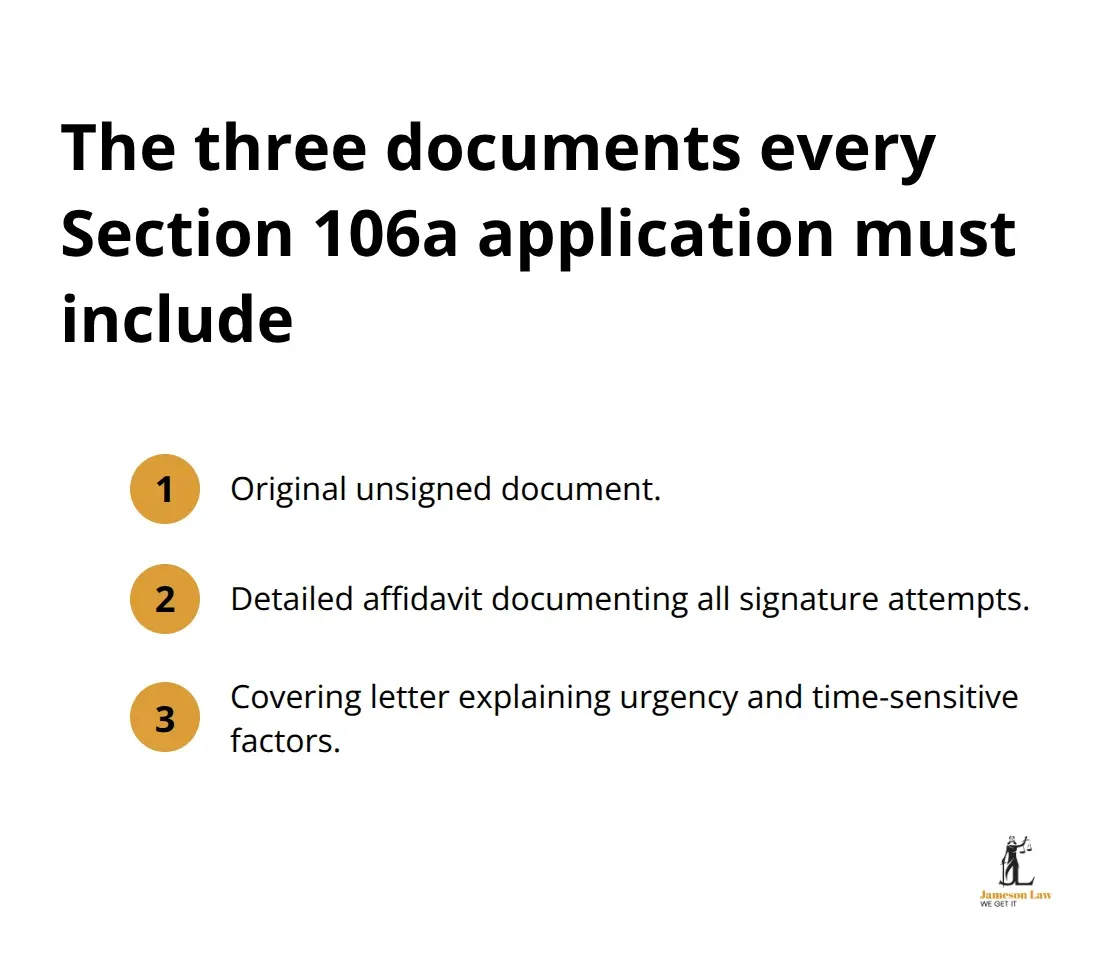Section 106a Family Law Act compliance remains one of the most challenging aspects of family law practice. Many practitioners struggle with the complex documentation and disclosure requirements.
We at Jameson Law see firms facing significant penalties due to inadequate preparation and poor record-keeping practices. This guide provides practical steps to meet all statutory obligations while protecting your practice from costly compliance failures.
What Does Section 106a Actually Require
Section 106a of the Family Law Act 1975 serves one primary function: it allows the Federal Circuit and Family Court of Australia to appoint another person to sign documents when a party refuses to comply with court orders. This provision becomes active when someone deliberately obstructs the execution of property settlements or financial arrangements and withholds their signature on transfer documents, mortgage discharges, or other legal instruments required to complete court-ordered transactions.
The Court’s Power to Override Non-Compliance
The court exercises this authority through a straightforward process. When you can demonstrate that your former partner refuses to sign necessary documents despite having a legal obligation to do so, the court can appoint a registrar, deputy registrar, or other suitable person to execute the documents on their behalf. This appointment carries the same legal weight as if the non-compliant party had signed personally. The appointed person acts with full authority to complete all required documentation (including property transfers and financial releases).

Mandatory Documentation Requirements
Family law practitioners must submit three specific documents for Section 106a applications: the original unsigned document, a detailed affidavit that outlines all attempts to obtain the signature, and a covering letter that explains the urgency of the request. Courts reject incomplete applications immediately, which delays resolution and increases costs for clients.
Evidence Standards and Compliance Obligations
Practitioners face strict evidentiary requirements when they pursue Section 106a relief. Your affidavit must chronicle every communication attempt, including dates, methods of contact, and responses received. The Federal Circuit and Family Court expects comprehensive evidence that shows reasonable efforts to secure voluntary compliance before it invokes this provision. Missing documentation or inadequate record-keeping will result in application delays or outright rejection.
Penalties and Professional Consequences
Courts impose penalties of up to 50 penalty units for practitioners who fail to meet documentation standards (approximately $8,000 under current penalty unit values for individuals). These penalties apply when practitioners submit incomplete applications or fail to demonstrate adequate compliance efforts. Professional negligence claims can also arise when poor preparation leads to delayed property settlements, making meticulous preparation essential for both legal and financial protection.
The next step involves understanding the specific obligations that practitioners must fulfil to maintain compliance with these requirements.
How to Build a Bulletproof Section 106a Application
Document Every Communication Attempt
Document every interaction with the non-compliant party from the moment you identify potential signature issues. The Federal Circuit and Family Court requires evidence of multiple contact attempts that span at least 14 days before it accepts Section 106a applications. Send formal letters via registered post, emails with delivery receipts, and text messages that create timestamped records.
Family law practitioners who maintain detailed communication logs see improved success rates in Section 106a applications. Your affidavit must include specific dates, exact wording of requests, and documented responses or lack thereof. Courts reject applications when practitioners present vague timelines or incomplete contact records.
Perfect the Three-Document Strategy
Prepare your original unsigned document with all parties identified and execution requirements clearly marked. Draft your supporting affidavit to include the full chronology of compliance efforts, specific reasons why the signature is required, and consequences of continued delay.

Write your covering letter to emphasise time-sensitive elements like settlement deadlines, mortgage requirements, or property sale contracts. Applications must be filed promptly after final compliance requests to receive priority processing, while delayed applications face additional scrutiny and potential rejection.
Meet Critical Processing Timeframes
The Australian Family Court processes complete Section 106a applications, but incomplete submissions can extend processing significantly. This delay causes significant client hardship and creates potential professional liability claims (particularly when property settlements face strict deadlines).
Courts impose strict penalties when practitioners submit incomplete applications or fail to demonstrate adequate compliance efforts. Professional negligence claims arise when poor preparation leads to delayed property settlements, making meticulous preparation essential for both legal and financial protection.
These documentation requirements form the foundation of successful applications, but practitioners must also navigate specific pitfalls that commonly derail Section 106a proceedings.
What Destroys Section 106a Applications
Rushed Client Consultations Create Fatal Gaps
Most Section 106a failures stem from inadequate client consultation records that cannot withstand court scrutiny. Practitioners who spend insufficient time on initial client meetings face significant rejection rates. Your consultation notes must capture specific details about property ownership, third-party interests, and potential compliance obstacles that could affect document execution.

Record every piece of advice you give to clients about their obligations under court orders. Courts expect evidence that you explained Section 106a procedures, potential delays, and alternative enforcement options during initial consultations. Missing consultation records create professional liability exposure when clients suffer financial losses due to delayed property settlements or missed mortgage deadlines.
Disclosure Failures That Trigger Automatic Rejections
Complete financial disclosure is required for all enforcement applications, yet practitioners consistently underestimate these requirements. Applications fail when practitioners omit recent property valuations, outstanding mortgage details, or third-party claims against assets subject to court orders. You must do everything a financial or property order requires and take all reasonable steps to ensure proper implementation.
Your disclosure obligations extend beyond basic asset identification to include detailed explanations of why specific documents require signatures and how delays affect your client’s financial position. Practitioners must provide current market valuations for all properties involved in transfer processes and detailed explanations of any encumbrances that could complicate document execution.
Critical Deadlines That Practitioners Miss
Section 106a applications face strict processing deadlines that many practitioners ignore until crisis points emerge. Applications filed after initial non-compliance receive delayed processing that can extend resolution significantly. This delay creates cascading problems for property settlements with fixed completion dates, mortgage discharge requirements, and buyer deposit obligations.
Courts prioritise applications that demonstrate immediate compliance efforts followed by prompt legal action when voluntary co-operation fails. Practitioners who wait months before pursuing Section 106a relief face additional evidentiary requirements and potential cost orders against their clients for unnecessary delays, particularly when property sales fall through due to missed settlement dates.
Final Thoughts
Section 106A Family Law Act compliance requires meticulous preparation and systematic documentation from every family law practitioner. Firms that maintain comprehensive communication records and meet strict disclosure requirements achieve significantly higher success rates in enforcement applications. Proper implementation protects your practice from the $8,000 penalty units imposed for inadequate documentation while it reduces professional liability exposure.
The Federal Circuit and Family Court processes complete applications efficiently, but incomplete submissions create delays that damage client relationships and financial outcomes. Practitioners who document every compliance attempt, prepare comprehensive affidavits, and file applications promptly after non-compliance emerges see measurably better results. Clients benefit from faster property settlements and reduced legal costs when practitioners follow established protocols from initial consultation through final document execution.
Family law practitioners should establish standardised documentation systems that capture all required evidence from the first client meeting (particularly for complex property matters). Regular training on Section 106A requirements and systematic case management protocols will strengthen your practice’s enforcement capabilities. We at Jameson Law provide expert guidance to navigate these complex requirements effectively.













